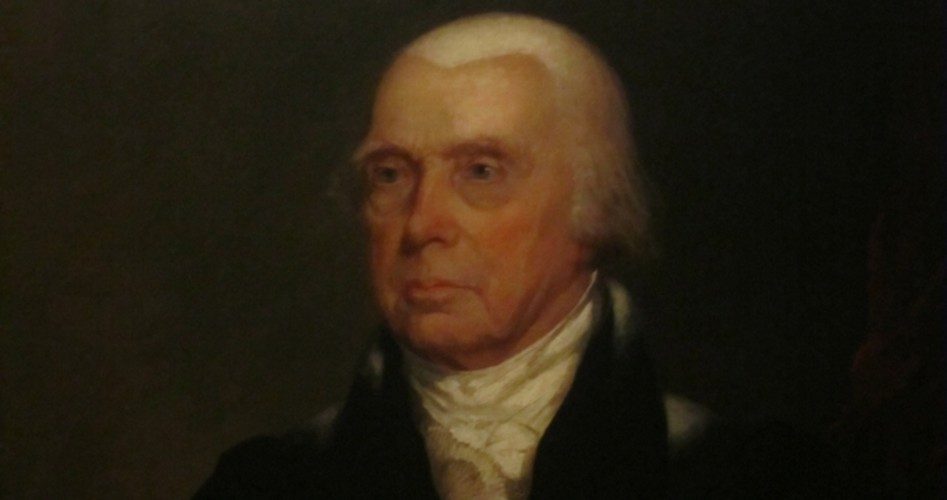
Despite being called the “Father of the Constitution,” there is no monument to James Madison in Washington, D.C. Well, there is a small statue of him inside the Library of Congress annex that bears his name, but it is dwarfed (as was the man himself) by the marble markers dedicated to his contemporaries, George Washington and Thomas Jefferson.
In 2001, on the 250th anniversary of Madison’s birth, George Will lamented the discrepancy:
There is no monument to James Madison in Washington. There is a tall, austere monument to the tall (6″2″), austere man for whom the city is named, a man of Roman virtues and eloquent reticence. There is a Greek-revival memorial to Madison’s boon companion, the tall (6″2″), elegant, eloquent Jefferson, who is to subsequent generations the most charismatic of the Founders. But there is no monument to the smallest (5″4″) but subtlest of the Founders, without whose mind Jefferson’s Declaration and Washington’s generalship could not have resulted in this republic.
In an article published in 2015, presidential historian Richard Brookhiser summed up the slight with a perfect metaphor. He writes:
The fourth U.S. president is often ignored — he’s not even on the currency anymore — but four new books remind us that tiny James Madison was a man to reckon with.
The Bible tells us that where our treasure is, there will our hearts be also. So where do we put the Founding Fathers on our money? George Washington occupies the quarter and, most important, the dollar bill. Over the years the Mint has rolled out dollar coins showing Ike, Susan B. Anthony, or Sacagawea, to no avail; Americans want the dollar to be scruffy paper with George on it. Thomas Jefferson holds the ubiquitous nickel and the elusive $2 bill. Alexander Hamilton gazes, buff and brash, from the tenner. And high rollers and drug dealers greet healthy, wealthy, and wise Benjamin Franklin on the C-note.
And where did we put James Madison? On the $5,000 bill. Which was discontinued in 1969.
No monument. No money. No matter.
To understand why this seeming slight wouldn’t bother the diminutive Madison, take a visit to his grave on the grounds of his Orange County, Virginia. You’ll instantly recognize the humility that was a hallmark of his life. The monument is a small, understated obelisk that mentions none of Madison’s impressive achievements.
For a bit of contrast, make the short drive to the much more popular Monticello (Thomas Jefferson’s estate). There you’ll see the much larger obelisk signaling the final resting place of the third president. Additionally, you’ll see Jefferson’s résumé etched into the stone, just as he directed. This is from the Monticello Web page:
Before his death, Thomas Jefferson left explicit instructions regarding the monument to be erected over his grave. In this document (undated), Jefferson supplied a sketch of the shape of the marker, and the epitaph with which he wanted it to be inscribed:
“…on the faces of the Obelisk the following inscription, & not a word more:”:
Here was buried
Thomas Jefferson
Author of the Declaration of American Independence
of the Statute of Virginia for religious freedom
& Father of the University of Virginia
“because by these,” he explained, “as testimonials that I have lived, I wish most to be remembered.”
While both men are gone and neither is forgotten, there has been no shortage of books chronicling the life of the so-called Sage of Monticello. As for Madison, there is a library, but with much fewer volumes. That seems on the cusp of changing, however.
Taking note of Madison’s bookishness and his happy receipt to crates of books from Jefferson while the latter was in Paris and the former prepared for the Constitutional Convention of 1787, Brookhiser reports:
Now Madison could study a literary cargo of books about himself. Four new titles join the list: The Quartet: Orchestrating the Second American Revolution, 1783-1789 by Joseph J. Ellis; Becoming Madison: The Extraordinary Origins of the Least Likely Founding Father by Michael Signer; The Bill of Rights: The Fight to Secure America’s Liberties by Carol Birken; and Madison’s Gift: Five Partnerships That Built America by David O. Stewart.
Each of these books is a worthy addition to the corpus of Madisoniana and reading of any one of these books reveals that James Madison’s skills were evident long before his prominent role at the Constitutional Convention of 1787, his authorship of most of the Federalist Papers, or his service to his new country as a U.S. congressman, secretary of state, and president. Regarding his assistance in drafting Virginia’s republican constitution in 1776, historian and Madison biographer, Kevin Gutzman writes:
It seems that Madison prepared for the task before him, writing the constitution, by assembling materials on the other colonies’ constitutional systems. In time, his diligent application would win him a reputation as consistently the best prepared and most knowledgeable (if not always the most perspicuous) man in American politics.
All the recently published books listed above are available now, and anyone interested in the extraordinary life and unparalleled contribution to the creation of the United States made by the inimitable James Madison would be well-served by reading any of them. In their pages, patriots will learn of the talents and tenacity that made James Madison a monumental man among monumental men.
This article was originally published on April 20, 2015.



